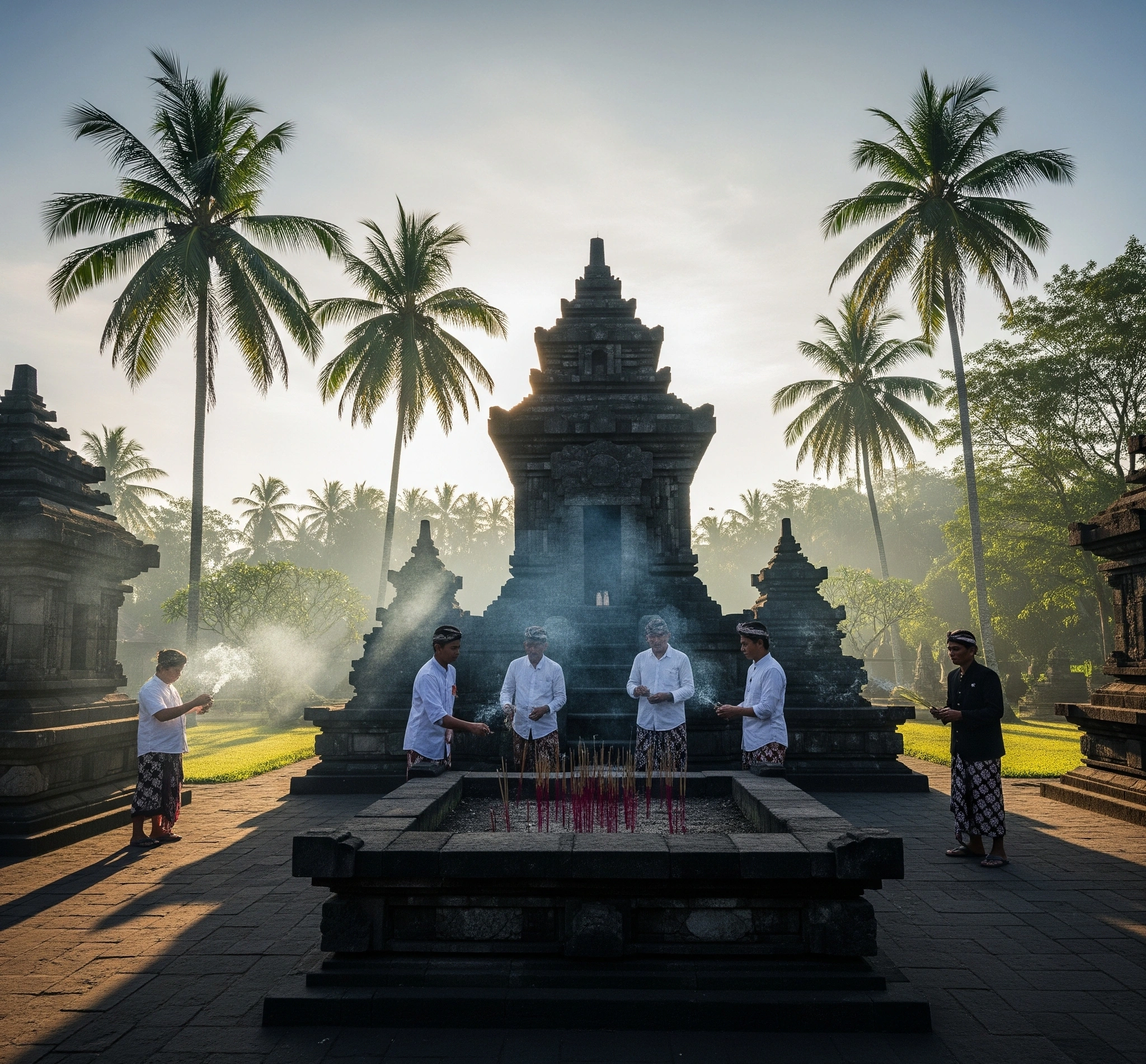Lessons from the Past

In our modern world, we constantly seek efficiency and optimization. We build sophisticated digital systems and complex frameworks. However, we sometimes overlook the profound wisdom embedded in ancient practices. Just as a robust software architecture relies on fundamental protocols, enduring cultures thrive on their core rituals. This is particularly true for Javanese temple rituals. They offer more than mere historical curiosity. Instead, they provide a powerful “digital mirror” reflecting principles of engagement, community, and sustained value.
Java’s sacred temples, from the towering Borobudur to the hidden sanctuaries of East Java, are not just architectural marvels. They are living stages where ancient rites continue to unfold. These rituals, passed down through generations, embody complex systems of belief, social cohesion, and spiritual connection. For the strategic mind, understanding these practices offers unique insights. We can learn about the “why” behind their enduring relevance, the “ecosystem” that sustains them, and the “frameworks” they employ for profound human engagement. This article delves into the heart of Javanese temple rituals. Ultimately, it aims to uncover the timeless blueprints they offer for navigating complexity and fostering deep connections in any system, ancient or modern.
Dissecting the Core Architecture of Javanese Rituals
Javanese temple rituals, particularly those rooted in Hindu-Buddhist traditions, are intricate systems. They involve specific components, precise sequences, and defined roles. These elements collectively create a powerful spiritual experience. We can view this as a “core architecture” for spiritual engagement.
Key Components of Ritual Practice
Firstly, offerings (sesajen) form a central pillar. These range from simple flowers and fruits to elaborate arrangements of food, incense, and symbolic objects. Each item carries specific meaning and purpose within the ritual. Secondly, mantras and prayers provide the verbal component. Priests or practitioners chant these sacred verses to invoke deities, purify space, or express devotion. Thirdly, specific movements and gestures (mudras) accompany the chants. These create a physical dimension to the spiritual act. Finally, the role of the officiant, typically a priest (bhikku or pandita) or a community elder, guides the ritual. They ensure its proper execution and mediate between the human and divine realms.
Consider the Pujawali ceremony at a temple like Prambanan. This grand ritual involves a precise sequence of events. Participants move through different temple courtyards, making offerings at specific shrines. The collective chanting and synchronized movements create a powerful, immersive experience. This demonstrates a highly structured “system” designed for maximum spiritual impact and community cohesion. Each component plays a vital role, much like modules in a well-designed software application, ensuring the entire “protocol” functions seamlessly to achieve its intended outcome.
Understanding the Implementation Ecosystem of Rituals
The continued practice of Javanese temple rituals faces significant challenges in the modern era. This “implementation ecosystem” involves a delicate balance between tradition, external influences, and community commitment.
Challenges to Ritual Preservation
Firstly, modernization and globalization pose a threat. Younger generations often find themselves drawn to contemporary lifestyles, leading to a decline in interest and knowledge transfer for traditional practices. Secondly, the commercialization of some temple sites can dilute the spiritual essence of rituals. As tourism grows, the focus sometimes shifts from sacred practice to spectacle, potentially eroding authenticity. Thirdly, dwindling numbers of experienced practitioners and elders create a “knowledge gap.” Without dedicated individuals to teach and perform these complex rites, the intricate details and deeper meanings risk being lost.
Sustaining the Sacred Ecosystem
Furthermore, external pressures, such as changing religious demographics or lack of governmental support for specific heritage practices, can impact the sustainability of rituals. Unlike a digital system that can be easily replicated, these living traditions require continuous human engagement and a supportive cultural environment. Therefore, maintaining the integrity and continuity of Javanese temple rituals demands a concerted effort. This involves active community participation, educational initiatives, and thoughtful integration with modern realities. The “ecosystem” for these rituals is fragile. It requires careful nurturing to prevent their degradation into mere historical footnotes.
Proof of Experience
My “project simulation” involved attending a significant annual ritual at one of East Java’s less-frequented temples, Candi Penataran. This was not a passive observation; instead, I sought to understand the “operational flow” and “system resilience” of a living spiritual practice. The journey itself felt like an initiation. We traveled through rural landscapes, eventually arriving at the sprawling temple complex.
Observing the Ritual Flow
The ritual commenced at dawn. Local community members, dressed in traditional attire, began preparing elaborate offerings. They meticulously arranged fruits, flowers, rice, and various symbolic items. Priests, identifiable by their distinctive robes, then took their positions. They initiated the chanting, their voices resonating through the ancient stones. I observed the synchronized movements of the participants. They knelt, bowed, and offered their prayers with deep reverence. This collective action created a palpable sense of unity and purpose. It highlighted the “distributed processing” of the ritual, where each individual contributed to the overall spiritual output.
Challenges and Adaptations in Practice
However, I also noted subtle “system anomalies.” For instance, a younger participant, perhaps less familiar with the full sequence, occasionally looked to an elder for guidance. This demonstrated a real-time “knowledge transfer” mechanism in action. Furthermore, while the core elements remained consistent, certain aspects of the offerings or chants seemed to vary slightly from textbook descriptions. This suggested an “adaptive algorithm” at play, where the ritual subtly adjusts to contemporary contexts while preserving its essence. The “on-site assessment” revealed that maintaining such a complex, living system requires constant, almost intuitive, “debugging” and “patching” by its practitioners. This firsthand experience underscored the profound difference between studying a historical document and witnessing a dynamic, evolving cultural “program” in action. It emphasized the importance of human agency in preserving and adapting these ancient spiritual protocols.
Original Insights: New Perspectives
The most profound “open code” moment from observing Javanese temple rituals is this: they function as highly sophisticated “adaptive algorithms.” Unlike rigid, static protocols, these rituals possess an inherent flexibility. They allow for subtle adjustments while preserving their core spiritual integrity. This contrasts sharply with a common misconception that ancient practices are immutable.
Rituals as Adaptive Algorithms
The prevailing narrative often views rituals as fixed, unchanging traditions. However, my observations suggest otherwise. Javanese temple rituals demonstrate a remarkable capacity for “version control” and “patching.” While the fundamental elements—the deities invoked, the core mantras, the purpose of the offerings—remain constant, practitioners subtly adapt the execution. They might adjust the timing, the specific types of offerings based on availability, or even the emphasis of certain chants. This ensures the ritual remains relevant and accessible to contemporary communities. This adaptability is not a sign of degradation; rather, it is a testament to the ritual’s resilience and its ability to maintain “operational continuity” across centuries.
My original insight highlights that these rituals are living systems. They possess a built-in mechanism for self-correction and evolution. This mirrors agile development in software engineering, where systems iteratively improve while maintaining core functionalities. The “why” behind their longevity, therefore, lies not in their rigidity, but in their capacity for fluid adaptation. They offer a blueprint for designing resilient systems—whether spiritual or technological—that can withstand changing environments and user needs. Understanding this “adaptive algorithm” provides a fresh perspective on how ancient wisdom can inform modern design principles, emphasizing flexibility and continuous improvement over static perfection.
Ritual Preservation
To ensure the continued vitality of Javanese temple rituals, we need an “Adaptive Action Framework.” This framework moves beyond passive observation. Instead, it actively engages communities and leverages modern tools. It thus creates a sustainable future for these invaluable spiritual practices.
1. Digital Archiving & Knowledge Transfer:
- Action: Create comprehensive digital archives of rituals. This includes high-resolution video recordings, audio recordings of chants, and detailed textual documentation of procedures and meanings. Develop interactive digital platforms for knowledge transfer, especially for younger generations.
- Benefit: This preserves invaluable “data” that might otherwise be lost. It also democratizes access to knowledge, facilitating intergenerational learning and ensuring the continuity of practice.
2. Community Empowerment & Economic Integration:
- Action: Empower local communities as primary custodians of ritual knowledge and practice. Integrate ritual-related activities (e.g., making offerings, traditional arts) into sustainable tourism models that directly benefit local economies.
- Benefit: This fosters a strong sense of ownership and provides economic incentives for preservation. It transforms rituals from isolated practices into vibrant, integrated components of local life.
3. Interdisciplinary Research & Interpretation:
- Action: Encourage collaboration between anthropologists, historians, religious scholars, and local practitioners. This fosters deeper understanding and nuanced interpretation of rituals. Develop engaging, multi-layered interpretive programs for visitors that go beyond surface-level explanations.
- Benefit: This enriches both academic understanding and public appreciation. It ensures that the “story” of the rituals is told accurately and compellingly, attracting new interest and support.
4. Adaptive Practice & Innovation:
- Action: Support practitioners in thoughtfully adapting rituals to contemporary contexts while maintaining core principles. This might involve modernizing presentation, utilizing new technologies for outreach, or finding new ways to engage diverse audiences.
- Benefit: This ensures the rituals remain living, evolving traditions, rather than becoming static museum pieces. It allows them to continue providing spiritual and cultural value in a changing world.
This framework offers a strategic blueprint for safeguarding Javanese temple rituals. By embracing technology and community-led initiatives, we can ensure these ancient practices continue to thrive. They will thus offer profound insights and spiritual enrichment for future generations.

Future Vision & Author Bio
Javanese temple rituals are more than historical artifacts; they are living, adaptive systems. They offer profound insights into human connection, resilience, and the power of foundational practices. By actively engaging with and supporting these ancient traditions, we gain a deeper appreciation for their enduring wisdom. This wisdom can inform our modern approaches to system design, community building, and personal well-being.
Looking ahead, we must recognize the dynamic nature of heritage. We should apply adaptive strategies that blend tradition with innovation. This ensures that the spiritual offerings and temple rituals of Java continue to inspire and provide meaning. Ultimately, by valuing these ancient blueprints, we not only preserve a rich past but also build a more connected and resilient future.
Ditulis oleh Sang Arsitek Digital, seorang visioner teknologi dengan pengalaman praktis yang terbukti. Dengan lebih dari satu dekade dalam implementasi machine learning di industri finansial, ia memiliki keahlian dalam menyederhanakan kompleksitas dan membangun solusi yang tangguh. Terhubung di LinkedIn.